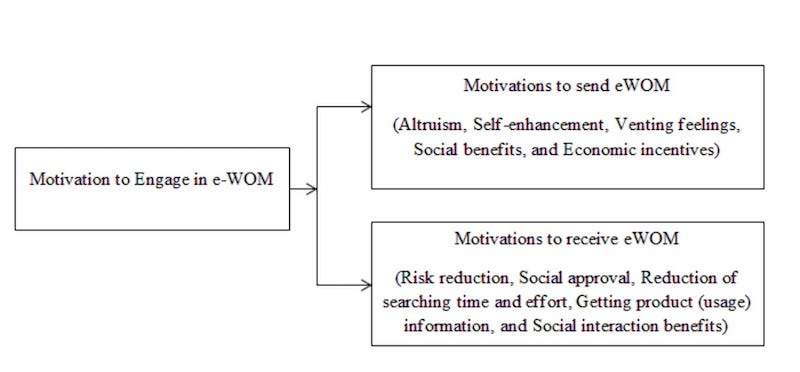Author: Md. Khalilur Rahman Khan – Former Assistant Professor
Bangladesh University of Business and Technology (Email: [email protected])
Abstract: Electronic word of mouth (e-WOM) emerged from the advent of the internet and social media platforms, and it is based on the traditional marketing channel of word-of-mouth. Consumers and influencers increasingly use e-WOM to share their experiences and viewpoints.
Prospective customers use e-WOM as a source of clothing inspiration, highlighting the importance of the internet in the apparel industry. As a result, eWOM communications has become a powerful tool for apparel merchandising. In fact, a greater understanding of the role of e-WOM in the clothing business is required on both a managerial and academic level. In this short review study, the very basic understanding of e-WOM for apparel merchandising is discussed.
Introduction
Word of mouth (WOM) is a method of verbal communication in which information is transmitted from one person to another in a social setting or in a circle. It is an informal interaction in which a satisfied consumer comments to potential customers about brands, products, and services [1,2]. It has generally been accepted as one of the most powerful methods of information dissemination.
WOM has been shown to have twice the impact of radio advertising, four times the impact of a sales representative, and seven times the impact of newspaper and magazine advertising [3]. In fact, the impact of word-of-mouth on consumer behavior has been clearly researched in marketing literature.
With the rise and availability of the internet, another form of word of mouth (WOM) has emerged: electronic word of mouth (e-WOM), which is regarded as one of the most convincing casual media among purchasers, businesses, and the public in general [4].
E-WOM is defined as a dynamic and ongoing information exchange process between futures, actual, or former customers about a product, service, brand, or company that is accessible to a large number of individuals and institutions through the internet. User-generated content, online product reviews, personal emails, and social media posts, blogging all serve as a basis of E-WOM. e-WOM has emerged as a significant topic in advertising, communication, and marketing research as digital media and new technologies continue to advance.
e-WOM is realized to be more persuasive than advertising and marketing campaigns in today’s society. Merchants regard e-WOM as more trustworthy and credible than advertising because it is spread through friends and family. Electronic word-of-mouth (e-WOM) communication has become increasingly significant in impacting consumer attitudes and behaviors in the context of trade competition and expanding digitization in industry.
Apparel is recognized one of the most crucial sectors because it contributes significantly to the global economy. It’s a fast-paced industry that necessitates regular adoption of cutting-edge technologies and concepts. Because the online clothing sector is growing, e-WOM has gotten a lot of interest from apparel marketers and researchers.
The purpose of this article is to review the motivating factors for e-WOM and their effects on consumer purchase intentions in short. Besides, certain researchers’ findings on e-WOM engagement in clothing items are briefly mentioned.
Motivations to Engage in E-WOM
Opinion leadership and opinion seeking have been two fundamental components for information to disseminate and circulate through a personal network. Some people try to advocate or persuade their acquaintances to follow them by expressing their opinions or thoughts (opinion leadership), while others seek information and ideas from their contacts to take appropriate decisions (opinion seeking) [5].
If an item performs beyond expectations, customers will be driven to share others about their pleasant experiences. If a client’s expectations are not satisfied, resulting in discontent, the customer will use e-WOM to vent and share their negative emotions. Altruism, s self-enhancement, venting feelings, social advantages, and economic incentives are the primary motivations (shown in figure-1) for participating in e-WOM. Customers who are upset or dissatisfied, for example, use e-WOM to vent their displeasure.
Additionally, a customer becomes a member of a virtual community by exchanging e-WOM on the internet. Affiliation with a virtual community can be beneficial to a person’s social life for a variety of reasons.
On the other hand, there are a variety of reasons for having or receiving e-WOM, including risk reduction, social approval, time and effort savings, product (usage) information, and benefits from social engagement. Consumers, for example, are driven to seek e-WOM in order to buy a product or service that other people like, be alert of a product’s social image, compare their ideas about an item to other people’s ideas, or desire other people’s acceptance of their purchasing decision [6].

Organic and Amplified e-WOM
When a person is willing to share others about a pleasant or negative experience with a product or a firm, organic e-WOM happens naturally. Individuals may share information and knowledge about a company and its products with their “friends” on social media because they believe it is socially acceptable (horizontal orientation) or because they want to show about their expertise (vertical orientation) [5].
This occurs among consumers as a result of their experiences and requires no direct participation from the company. Amplified e-WOM, on the other hand, happens when a marketer begins a campaign or promotes others to talk about a product or a brand in some other way. Marketing managers are increasingly using agent campaigns, opinion leader initiatives, and viral marketing to impact customer-to-customer interactions [7].
E-WOM and Purchase Intention
Consumers now have access to an unprecedented amount of product information thanks to the growth of digital technology. Not only is there more information available, but customers are actively using it—and undertaking their own “study” prior reaching a retailer’s location to place an order. Consumers commonly develop and seek for electronic word of mouth (e-WOM) information to lower perceived risk while making purchasing selections [7].
They are highly interested in reading both the bad and positive feedback from other users. These favorable and negative comments have an impact on potential buyers’ purchase intentions for fashion products [8]. Consumers that use e-WOM communication have better confidence in their ability to grasp products and services, minimize their risk of making poor purchasing decisions, and receive social acceptance [2]. In both online and physical retail channels, E-WOM has modified shopper choices.
The effectiveness of e-WOM and its influence on purchase decisions, on the other hand, is linked to source credibility, which means that if the person recommending a product/company is perceived as credible by the audience, the impact on their decision-making process is greater than if they are not [9].
Saleem et al. studied the major factors for the influence of e-WOM on the purchase intention concerning fashion products. They concluded homophily, or consumers who have similar values and tastes, may have a greater impact on e-WOM. Similarly, knowing the reviewer’s level of expertise encourages more participants to enter in electronic word of mouth, thereby increasing their desire to buy fashion products.
Furthermore, e-WOM is influenced by two other major factors: trustworthiness and informational influence [8]. Because online purchase intention entails a higher level of risk and uncertainty than traditional brick and mortar purchases, trust plays an important role in influencing online purchase intention [4].
E-WOM as a Marketing Tool
Marketers are continuously trying to figure out what their customers want since it’s important to know how they think, feel, and choose amongst several choices [10]. For a long time, electronic word of mouth (e-WOM) has been regarded as a powerful marketing tool. As a result, comprehending electronic word-of-mouth (e-WOM) among social media users has become a critical responsibility for marketers in order to get insight into consumers’ wants and needs and to design, promote, and deploy marketing efforts [5].
Consumers can offer product reviews and feedback on websites connected to the products they buy from online sellers. Consumers now engage with other consumers using social networking sites (SNS) such as Twitter, Facebook, and YouTube, in addition to retailers’ websites [3].
Consumers post freely about their values, interpretations, and feelings, and they trust other consumers’ comments more than marketing specialists’. As a result, marketing experts have realized the need of encouraging consumer-to-consumer (C2C) electronic word-of-mouth (e-WOM) with rewards including free items and services, coupons, and rebates [7].
Negative and positive e-WOM can result in both losses and opportunities for businesses respectively. Therefore, businesses should carefully monitor and manage the e-WOM process on social media platforms. Identifying the factors that influence e-WOM and, as a result, purchase intention can effectively assist companies in spreading favorable e-WOM about their products on social networking sites in order to acquire a large client base [8].
E-WOM in Apparel Merchandising
Apparel items are highly symbolic products that represent a person’s values and likes, as well as her or his social position. People frequently connect with their peers and seek confirmation of social acceptance from them [3]. Furthermore, the apparel fashion sector has evolved dramatically in the internet era, and this trend is expected to continue as new forms of online business models are required to meet increasingly demanding and digitalized consumers. In fact, in the age of omnichannel merchandising, leveraging the benefits of e-WOM is critical in order to boost clothing retailing.
Several researchers investigated the e-WOM engagement in textile clothing [1-3,11-12]. Kim et al. studied the effects of E-WOM on consumers’ internet apparel shopping behaviour. The findings suggest that individuals who had interaction with E-WOM (68.4% of participants) purchased more frequently than those who did not. They also found that a negative E-WOM message had a greater influence on people than a positive message.
As a result, merchants should make an effort to resolve/reconcile objections about their products and services in order to eliminate unwanted E-WOM in the future [3]. In addition, Melissa Abner also revealed that positive eWOM had higher attitude towards purchasing ethical apparel, allowing sustainability, which is one of the biggest challenges for the apparel industry [13]. However, future researchers may perform studies focusing the e-WOM engagement in apparel merchandising in terms of value co-creation.
References:
[1] Dr. A.Kadhar Lal M.Com, M.Phil, MBA, Ph.D,V.Dakshinamoorthy. (2020), Influence Of Electronic Word Of Mouth On Consumer Buying Behaviour With Reference To Clothing In Chennai City– Palarch’s Journal of Archaeology of Egypt/Egyptology 17(7): 11422 – 11436. https://archives.palarch.nl/index.php/jae/article/view/4517
[2] Muniweera, C. D. W., Balawardhana, K. P. I. A., Rajapaksha, M. S. N., Chamara, M. A. D. S., & Jayasuriya, N. A. (2020). The Importance of Factors Influencing on e-WOM Engagement towards Consumer Purchase Intention in Clothing Retailers, Sri Lanka. International Journal of Academic Research in Business and Social Sciences, 10(5), 349–360.
[3] Sookhyun Kim, Jiyoung Park & Yuri Lee (2013) The E-Word-of-Mouth effect on consumers’ Internet shopping behaviour: focus on apparel products, International Journal of Fashion Design, Technology and Education, 6:3, 160-172, DOI: 10.1080/17543266.2013.798355
[4] Abir, Tanvir & Rahman, Md & Nur A Yazdani, Dewan & Khan, Rubaiyet & Supty, Syeda & Abdul Hamid, Abu Bakar. (2020). Electronic Word of Mouth (e-WOM) and consumers’ purchase decisions: Evidences from Bangladesh. Xi’an Jianzhu Keji Daxue Xuebao/Journal of Xi’an University of Architecture & Technology. 12. 367-382. 10.37896/JXAT12.04/782.
[5] Youngtae Choi & Junga Kim (2019) Influence of Cultural Orientations on Electronic Word-of-Mouth (eWOM) in Social Media, Journal of Intercultural Communication Research, 48:3, 292-313, DOI: 10.1080/17475759.2019.1627388
[6] Ismagilova, Elvira & Dwivedi, Yogesh & Slade, Emma & Williams, Michael. (2017). Electronic Word of Mouth (eWOM) in the Marketing Context. 10.1007/978-3-319-52459-7.
[7] Kulmala, M., Mesiranta, N., & Tuominen, P. (2013). Organic and amplified eWOM in consumer fashion blogs. Journal of Fashion Marketing and Management: An International Journal, 17(1), 20–37. doi:10.1108/13612021311305119
[8] Saleem, Anum & Ellahi, Abida. (2017). Influence of Electronic Word of Mouth on Purchase Intention of Fashion Products on Social Networking Websites. Pakistan Journal of Commerce and Social Sciences. 2017. 597-622.
[9] Quiterio Capeli, Marilia, “Micro-influencers’ impact on engagement levels for fashion retail brands on Instagram” (2019). UNF Graduate Theses and Dissertations. 884. https://digitalcommons.unf.edu/etd/884
[10] Mehyar, Hamzah & Saeed, Mohammed & Baroom, Hussein & Aljaafreh, Ali & Al-Adaileh, Raid. (2020). The Impact Of Electronic Word Of Mouth On Consumers Purchasing Intention. Journal of Theoretical and Applied Information Technology. 98. 183-193.
[11] Kristia, K. (2021). Mediating Effect of Customer Engagement on the Relations between eWOM, Environmental Concern, and Intention to Purchase Second-hand Clothing among College Students in Yogyakarta. Jurnal Manajemen Bisnis, 12(2), 162–175. doi:10.18196/mb.v12i2.11424
[12] Nasir, Saadia; Vel, Prakash; and Mateen, Hafsa: Social media and buying behaviour of women in Pakistan towards the purchase of textile garments 2012, 61-69. https://ro.uow.edu.au/dubaipapers/414
[13] Abner, Melissa, “Effects of social media, electronic word-of-mouth, and price on U.S. female consumers’ attitude toward purchase and purchase intention of ethical apparel” (2019). Graduate Theses and Dissertations. 16950.
https://lib.dr.iastate.edu/etd/16950






















